+ Open data
Open data
- Basic information
Basic information
| Entry | Database: PDB / ID: 6v0b | ||||||
|---|---|---|---|---|---|---|---|
| Title | Unliganded ELIC in POPC-only nanodiscs. | ||||||
 Components Components | Gamma-aminobutyric-acid receptor subunit beta-1 | ||||||
 Keywords Keywords |  MEMBRANE PROTEIN / Pentameric Ligand-gated Ion Channels / MEMBRANE PROTEIN / Pentameric Ligand-gated Ion Channels /  POPC / POPC /  Nanodisc / Cys-loop receptors Nanodisc / Cys-loop receptors | ||||||
| Function / homology |  Function and homology information Function and homology informationextracellular ligand-gated monoatomic ion channel activity / transmembrane signaling receptor activity /  membrane / identical protein binding membrane / identical protein bindingSimilarity search - Function | ||||||
| Biological species |   Dickeya dadantii (bacteria) Dickeya dadantii (bacteria) | ||||||
| Method |  ELECTRON MICROSCOPY / ELECTRON MICROSCOPY /  single particle reconstruction / single particle reconstruction /  cryo EM / Resolution: 4.1 Å cryo EM / Resolution: 4.1 Å | ||||||
 Authors Authors | Grosman, C. / Kumar, P. | ||||||
| Funding support |  United States, 1items United States, 1items
| ||||||
 Citation Citation |  Journal: Proc Natl Acad Sci U S A / Year: 2020 Journal: Proc Natl Acad Sci U S A / Year: 2020Title: Cryo-EM structures of a lipid-sensitive pentameric ligand-gated ion channel embedded in a phosphatidylcholine-only bilayer. Authors: Pramod Kumar / Yuhang Wang / Zhening Zhang / Zhiyu Zhao / Gisela D Cymes / Emad Tajkhorshid / Claudio Grosman /  Abstract: The lipid dependence of the nicotinic acetylcholine receptor from the electric organ has long been recognized, and one of the most consistent experimental observations is that, when reconstituted in ...The lipid dependence of the nicotinic acetylcholine receptor from the electric organ has long been recognized, and one of the most consistent experimental observations is that, when reconstituted in membranes formed by zwitterionic phospholipids alone, exposure to agonist fails to elicit ion-flux activity. More recently, it has been suggested that the bacterial homolog ELIC ( ligand-gated ion channel) has a similar lipid sensitivity. As a first step toward the elucidation of the structural basis of this phenomenon, we solved the structures of ELIC embedded in palmitoyl-oleoyl-phosphatidylcholine- (POPC-) only nanodiscs in both the unliganded (4.1-Å resolution) and agonist-bound (3.3 Å) states using single-particle cryoelectron microscopy. Comparison of the two structural models revealed that the largest differences occur at the level of loop C-at the agonist-binding sites-and the loops at the interface between the extracellular and transmembrane domains (ECD and TMD, respectively). On the other hand, the transmembrane pore is occluded in a remarkably similar manner in both structures. A straightforward interpretation of these findings is that POPC-only membranes frustrate the ECD-TMD coupling in such a way that the "conformational wave" of liganded-receptor gating takes place in the ECD and the interfacial M2-M3 linker but fails to penetrate the membrane and propagate into the TMD. Furthermore, analysis of the structural models and molecular simulations suggested that the higher affinity for agonists characteristic of the open- and desensitized-channel conformations results, at least in part, from the tighter confinement of the ligand to its binding site; this limits the ligand's fluctuations, and thus delays its escape into bulk solvent. | ||||||
| History |
|
- Structure visualization
Structure visualization
| Movie |
 Movie viewer Movie viewer |
|---|---|
| Structure viewer | Molecule:  Molmil Molmil Jmol/JSmol Jmol/JSmol |
- Downloads & links
Downloads & links
- Download
Download
| PDBx/mmCIF format |  6v0b.cif.gz 6v0b.cif.gz | 276.8 KB | Display |  PDBx/mmCIF format PDBx/mmCIF format |
|---|---|---|---|---|
| PDB format |  pdb6v0b.ent.gz pdb6v0b.ent.gz | 224.9 KB | Display |  PDB format PDB format |
| PDBx/mmJSON format |  6v0b.json.gz 6v0b.json.gz | Tree view |  PDBx/mmJSON format PDBx/mmJSON format | |
| Others |  Other downloads Other downloads |
-Validation report
| Arichive directory |  https://data.pdbj.org/pub/pdb/validation_reports/v0/6v0b https://data.pdbj.org/pub/pdb/validation_reports/v0/6v0b ftp://data.pdbj.org/pub/pdb/validation_reports/v0/6v0b ftp://data.pdbj.org/pub/pdb/validation_reports/v0/6v0b | HTTPS FTP |
|---|
-Related structure data
| Related structure data |  20986MC  6v03C M: map data used to model this data C: citing same article ( |
|---|---|
| Similar structure data |
- Links
Links
- Assembly
Assembly
| Deposited unit | 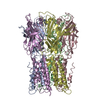
|
|---|---|
| 1 |
|
- Components
Components
| #1: Protein | Mass: 36879.000 Da / Num. of mol.: 5 Source method: isolated from a genetically manipulated source Source: (gene. exp.)   Dickeya dadantii (strain 3937) (bacteria) Dickeya dadantii (strain 3937) (bacteria)Strain: 3937 / Gene: Dda3937_00520 Production host:   Escherichia coli 'BL21-Gold(DE3)pLysS AG' (bacteria) Escherichia coli 'BL21-Gold(DE3)pLysS AG' (bacteria)Strain (production host): BL21 / References: UniProt: E0SJQ4 |
|---|
-Experimental details
-Experiment
| Experiment | Method:  ELECTRON MICROSCOPY ELECTRON MICROSCOPY |
|---|---|
| EM experiment | Aggregation state: PARTICLE / 3D reconstruction method:  single particle reconstruction single particle reconstruction |
- Sample preparation
Sample preparation
| Component | Name: Unliganded ELIC in POPC-only nanodiscs. / Type: COMPLEX / Entity ID: all / Source: RECOMBINANT | ||||||||||||||||||||
|---|---|---|---|---|---|---|---|---|---|---|---|---|---|---|---|---|---|---|---|---|---|
| Molecular weight | Experimental value: NO | ||||||||||||||||||||
| Source (natural) | Organism:   Dickeya dadantii 3937 (bacteria) Dickeya dadantii 3937 (bacteria) | ||||||||||||||||||||
| Source (recombinant) | Organism:   Escherichia coli 'BL21-Gold(DE3)pLysS AG' (bacteria) Escherichia coli 'BL21-Gold(DE3)pLysS AG' (bacteria) | ||||||||||||||||||||
| Buffer solution | pH: 8 / Details: 150 mM NaCl and 10 mM sodium phosphate, pH 8.0. | ||||||||||||||||||||
| Buffer component |
| ||||||||||||||||||||
| Specimen | Conc.: 2 mg/ml / Embedding applied: NO / Shadowing applied: NO / Staining applied : NO / Vitrification applied : NO / Vitrification applied : YES : YES | ||||||||||||||||||||
| Specimen support | Grid material: GOLD / Grid type: Homemade | ||||||||||||||||||||
Vitrification | Instrument: SPOTITON / Cryogen name: ETHANE |
- Electron microscopy imaging
Electron microscopy imaging
| Experimental equipment |  Model: Titan Krios / Image courtesy: FEI Company |
|---|---|
| Microscopy | Model: FEI TITAN KRIOS |
| Electron gun | Electron source : :  FIELD EMISSION GUN / Accelerating voltage: 300 kV / Illumination mode: SPOT SCAN FIELD EMISSION GUN / Accelerating voltage: 300 kV / Illumination mode: SPOT SCAN |
| Electron lens | Mode: BRIGHT FIELD Bright-field microscopy / Cs Bright-field microscopy / Cs : 2.7 mm : 2.7 mm |
| Image recording | Electron dose: 63.56 e/Å2 / Detector mode: COUNTING / Film or detector model: DIRECT ELECTRON DE-16 (4k x 4k) |
- Processing
Processing
| EM software | Name: RELION / Version: 2.1 / Category: 3D reconstruction | ||||||||||||||||||||||||
|---|---|---|---|---|---|---|---|---|---|---|---|---|---|---|---|---|---|---|---|---|---|---|---|---|---|
CTF correction | Type: NONE | ||||||||||||||||||||||||
| Particle selection | Num. of particles selected: 289375 | ||||||||||||||||||||||||
| Symmetry | Point symmetry : C5 (5 fold cyclic : C5 (5 fold cyclic ) ) | ||||||||||||||||||||||||
3D reconstruction | Resolution: 4.1 Å / Resolution method: FSC 0.143 CUT-OFF / Num. of particles: 29207 / Symmetry type: POINT | ||||||||||||||||||||||||
| Atomic model building | Protocol: RIGID BODY FIT / Space: REAL | ||||||||||||||||||||||||
| Refinement | Stereochemistry target values: GeoStd + Monomer Library + CDL v1.2 | ||||||||||||||||||||||||
| Displacement parameters | Biso mean: 138.12 Å2 | ||||||||||||||||||||||||
| Refine LS restraints |
|
 Movie
Movie Controller
Controller




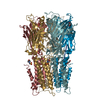
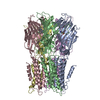
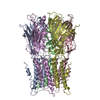
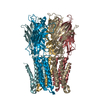
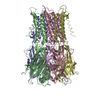
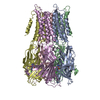
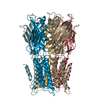
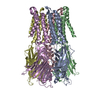
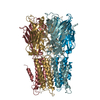

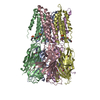
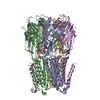
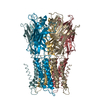
 PDBj
PDBj


